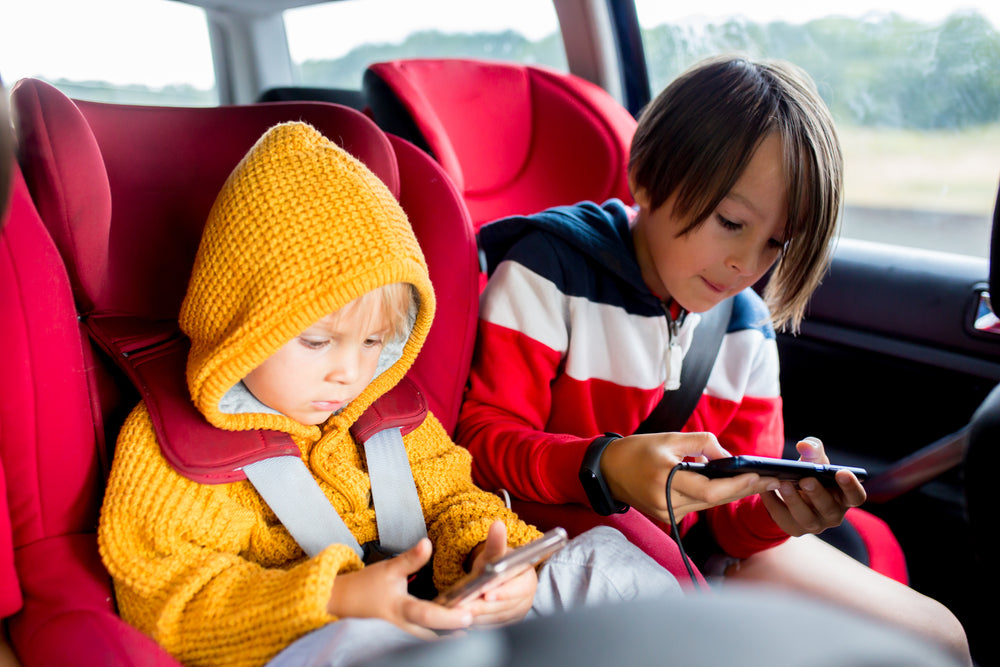Your Cart is Empty
Did you know that having children screaming in a moving car is more dangerous than using a cell phone while driving?
This was the conclusion of a study done by researchers from Australia’s Monash University. The researchers established that children are a dozen times more distracting to a driver than using a mobile phone while in control of a moving vehicle.
Such conclusions lead to an important question. Are parents better off allowing more than usual screen time to keep children busy and less distracting inside a car?
This is the question we attempt to answer in this article. We start by defining screen time and scream time. We then focus on the effects of screen time on children. Finally, we provide some tips on how you can take advantage of screen time to keep children happy when taking a road trip.
MedlinePlus.gov, a website of the National Library of Medicine, defines screen time as “a term used for activities done in front of a screen, such as watching TV, working on a computer, or playing video games.”
The same source adds, “Screen time is [a] sedentary activity, meaning you are being physically inactive while sitting down.”
Estimates indicate that an American child spends between five and seven hours per day engaged in screen time.
A group of scholars led by Taren Sanders from the Institute for Positive Psychology and Education at the Australian Catholic University conducted a study focusing on the effects of screen time on children.
The study, published by the International Journal of Behavioral Nutrition and Physical Activity, categorizes screen time into five types:

An article written by Kristy Goodwin and published by HuffPost.com provides a good idea of what scream time involves: “when our otherwise well-adjusted child (not necessarily a toddler) bursts into tears when we ask for our smartphone to be handed over, or the TV to be switched off.”
Goodwin calls this type of screaming a “techno-tantrum.” However, scream time happens for different reasons, including when children seek attention, are frustrated, or hungry.
Since there is no single reason children scream, it can be inferred that dealing with screaming cannot be a matter of a single solution. For example, it’s impossible to solve all screaming by simply handing the child an electronic device or more screen time.

The screen time vs. scream time debate is often driven by concerns about the adverse effects of the former on children. Often, this debate ignores the positive contributions of screen time.
An article by Nick Morrison, published by Forbes.com, is titled “Screen Time Is Not As Dangerous As You Think—And It May Help Your Child Make Friends.”
Morrison starts by noting, “It has become fashionable to portray screen time as the curse of the modern age, responsible for everything from childhood obesity to mental health problems.”
Morrison cites researchers who conclude that children that spend more time on screens have more friends. He adds that this could be attributed to the reality that “the social nature of screen time strengthened relationships and enabled children to stay connected even when apart.”
Apart from helping children make more friends, there are several other advantages of screen time.
One of the main advantages of the proliferation of information and communication technologies often accessed through devices with screens is that they have made it possible for children to learn everywhere at any time.
Eric Mack writes for Forbes.com and cites researchers who concluded that “children who spend one to two hours daily watching television or using digital devices had higher levels of social and emotional well-being versus those who reported no screen time.”
The ability to interact with the devices involved in screen time can help children embrace the technology they will require in life to successfully navigate careers based on modern technologies. This reduces the digital gap, ensuring that kids are not left behind by their peers in terms of their ability to interact with technology.
There is no doubt that too much of anything is not good for anyone. Because screen time presents several advantages does not imply that it should be your default whenever you don’t know what to do with your children.
The non-profit provider of medical information, services, and news, Mayo Clinic, identifies some of the negative effects of too much screen time:
From the insights above, it’s clear that screen time can be a healthy way of keeping children busy during a road trip. However, it is also vital to realize that the parent has a considerable role to play in ensuring that children use screen time in a way that takes advantage of its benefits.
Here are some tips you may follow when you allow kids to have more screen time on road trips:
Before the trip, agree with the children regarding the rules followed when using gadgets during the journey. Whatever you agree on, make sure that everybody’s input is considered. This will ensure harmony and respect for the needs of others in the car.
During this pre-trip talk, help the kids understand the advantages and disadvantages of screen time. For example, you could decide on some educational or social tasks the kids can do during the trip and then have a discussion about them during breaks.
This time could also allow you to preview the activities that children will participate in during the trip.
Comfortable kids are happy kids. One way of ensuring that the kids are comfortable is by making sure that they have a way of mounting their gadgets so that they don’t have to hold them in their hands the whole trip.
If you have teenagers sitting in the front seat using a phone, check some cool cup phone holders and get one for them.
You can get a headrest gadget holder for the kids at the back. If you don’t have money to buy one, 100things2do.ca has some great ideas on how you can DIY.
If you can afford it, it would be great to get each child their own gadget to use on the trip. For each gadget, have a set of headphones so that you don’t have children screaming eat each other because they are irritated by the noise from the other’s device.
Mayoclinic.org advises, “Seek out interactive options that engage your child, rather than those that just require pushing and swiping or staring at the screen.”
Consider the interest of the child when you select these interactive options. Verywellfamily.com identifies some cool apps for kids you may use on your next road trip.
Even though screen time can go a long way in ensuring that the kids keep busy during a trip, don’t over-rely on it. This means that you should consider other activities such as reading or having a conversation.

“Roads are made for journeys, not for destinations,” is a saying attributed to Confucius, the Chinese philosopher, and politician. This means that a road trip should never be treated as something that has to be endured but rather a joy to participate in.
Encourage the kids to enjoy the trip just by sitting and watching the trees go by. If there is some exciting information you can tell them about places you are passing, by all means, talk about them. Encourage children to link what they see along the road with what they have learned in school.
